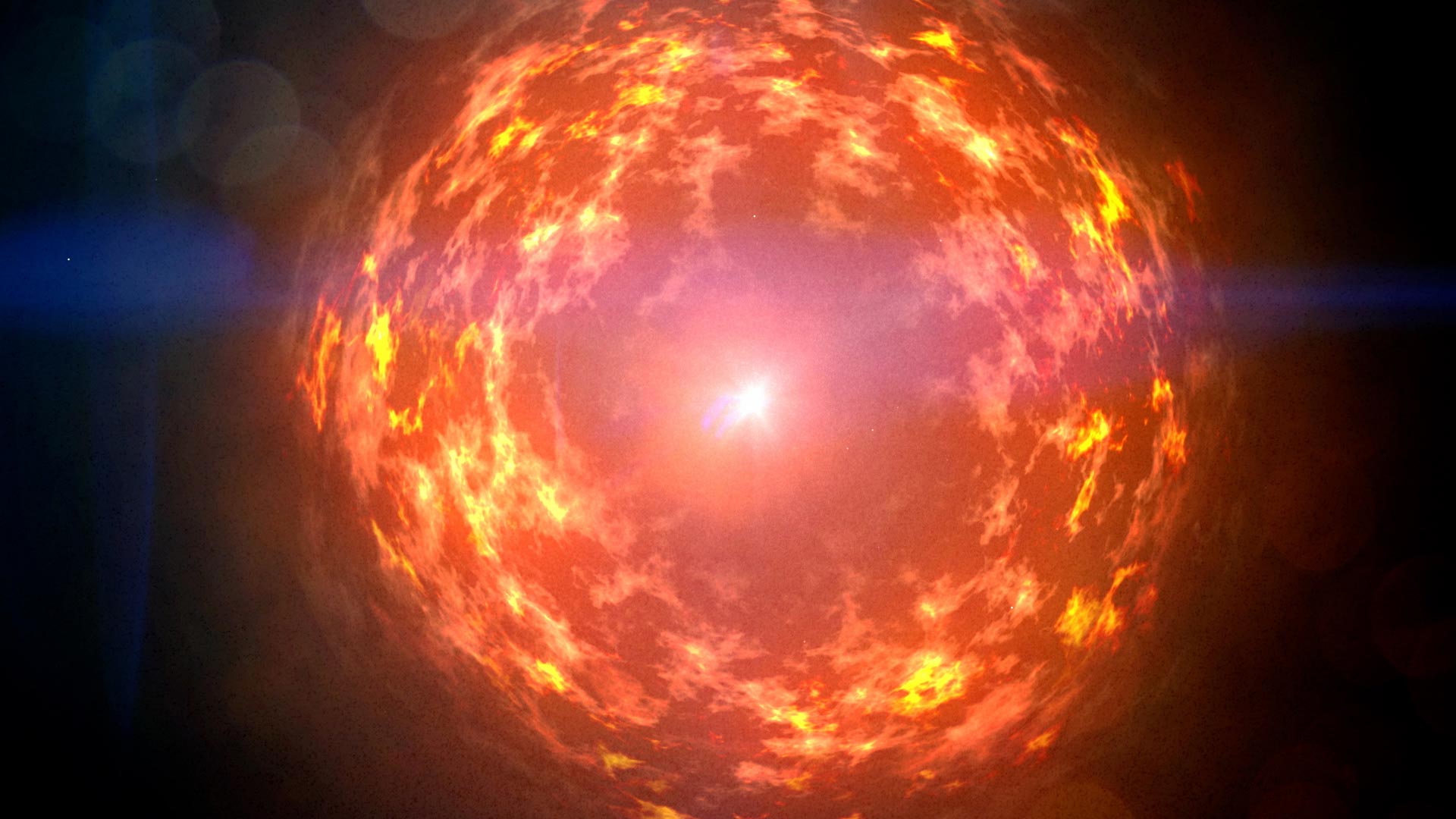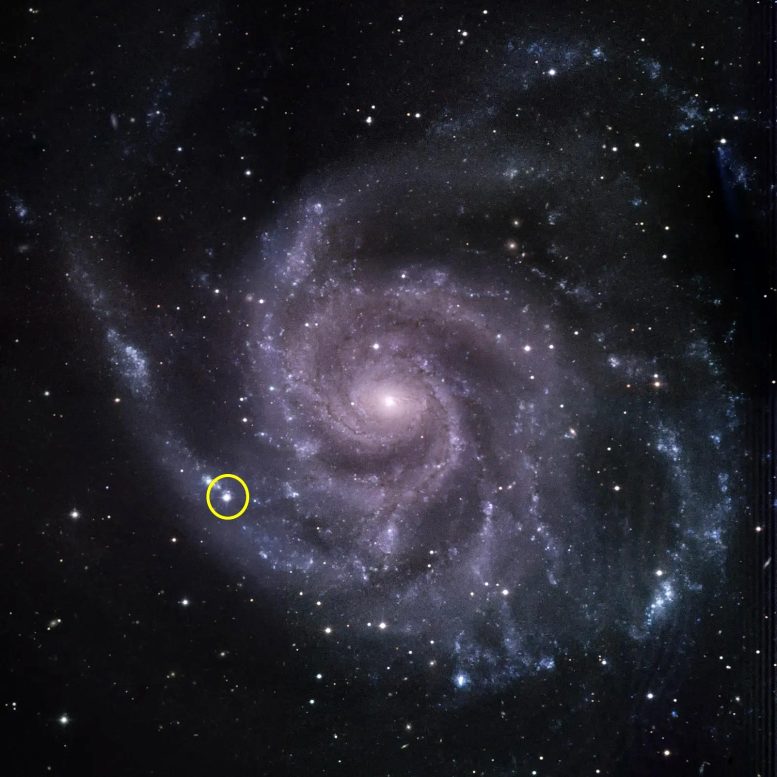
Observation of the supernova SN 2023ixf in 2023 in the Pinwheel Galaxy provided a unique opportunity to study cosmic ray production, but the expected gamma rays were not detected by NASA's Fermi telescope, indicating much lower energy conversion rates than expected. Credit: NASA
Observations of SN 2023ixf in 2023 led to surprising results regarding the production of cosmic rays by supernovas, with potential implications for understanding the origins of cosmic rays and acceleration mechanisms.
In 2023, a nearby supernova provided astrophysicists with an excellent opportunity to test ideas about how these types of explosions boost particles, called cosmic rays, to near-light speeds. But surprisingly, NASA's Fermi Gamma-ray Space Telescope did not detect any of the high-energy gamma-ray light that those particles should produce.
On May 18, 2023, a supernova erupted in the nearby Pinwheel Galaxy (Messier 101), located about 22 million light-years away in the constellation Ursa Major. The event, called SN 2023ixf, is the brightest nearby supernova discovered since Fermi's launch in 2008.
Unexpected results from the Fermi telescope
“Astrophysicists previously estimated that supernovas convert about 10% of their total energy into accelerated cosmic rays,” said Guillem Martí Devesa, a researcher at the University of Trieste in Italy. “But we have never observed this process directly. With the new observations of SN 2023ixf, our calculations lead to an energy conversion as low as 1% within a few days after the explosion. This does not rule out supernovae as cosmic ray factories, but it does mean that we have More to learn about its production.
This paper, conducted by Martti Devesa while at the University of Innsbruck in Austria, will appear in a future edition of the journal Astronomy and astrophysics.
Even when gamma rays are not detected, NASAFermi's Fermi Gamma-ray Space Telescope helps astronomers learn more about the universe. Source: NASA Goddard Space Flight Center
Cosmic rays and their origins
Trillions upon trillions of cosmic rays collide with Earth's atmosphere every day. Roughly 90% of them are hydrogen nuclei – or protons – and the rest are electrons or nuclei of heavier elements.
Scientists have been studying the origins of cosmic rays since the early 1900s, but the particles cannot be traced back to their sources. Because they are electrically charged, cosmic rays change their path as they travel to Earth thanks to the magnetic fields they encounter.
“Gamma rays travel directly to us,” said Elizabeth Hayes, Fermi project scientist at NASA's Goddard Space Flight Center in Greenbelt, Maryland. “Cosmic rays produce gamma rays when they interact with matter in their environment. Fermi is the most sensitive gamma-ray telescope in orbit, so when it doesn't detect an expected signal, scientists must explain the absence. Solving this puzzle will build a more accurate picture of the origins of cosmic rays .

The Fred Lawrence Whipple Observatory's 48-inch telescope captured this visible-light image of the Pinwheel Galaxy (Messier 101) in June 2023. The location of supernova 2023ixf is circled. The observatory, located on Mount Hopkins in Arizona, is operated by the Harvard-Smithsonian Center for Astrophysics. Credit: Hiramatsu et al. 2023/Sebastian Gomez (STScI)
Supernovas as cosmic ray accelerators
Astrophysicists have long suspected that supernovae are the biggest contributors of cosmic rays.
These explosions occur when a star with a mass at least eight times the mass of the Sun runs out of fuel. The core collapses and then rebounds, pushing the shock wave outward through the star. The shock wave accelerates the particles, creating cosmic rays. When cosmic rays collide with other matter and light surrounding the star, they generate gamma rays.
Supernovas greatly affect the interstellar environment in the galaxy. The blast waves and expanding debris cloud may last for more than 50,000 years. In 2013, Fermi measurements showed that supernova remnants exist on our planet milky way The galaxies were accelerating cosmic rays, which generate gamma-ray light when they collide with interstellar matter. But astronomers say the remnants don't produce enough high-energy particles to match scientists' measurements on Earth.
One theory suggests that supernovas may accelerate the most energetic cosmic rays in our galaxy in the first few days and weeks after the initial explosion.
But supernovas are rare, occurring only a few times every century in a galaxy like the Milky Way. About 32 million light-years away, supernovae occur, on average, only once a year.
After a month of observations, starting with visible-light telescopes' first sighting of SN 2023ixf, Fermi was unable to detect gamma rays.
Challenges and future research
“Unfortunately, not seeing gamma rays does not mean that there are no cosmic rays,” said co-author Mathieu Renaud, an astrophysicist at the Montpellier Laboratory of the Universe and Particles, part of the National Center for Scientific Research in France. “We have to revise all fundamental hypotheses regarding acceleration mechanisms and environmental conditions in order to convert the absence of gamma rays into an upper limit for cosmic ray production.”
The researchers suggest some scenarios that may have affected Fermi's ability to see gamma rays from the event, such as the way the explosion distributed debris and the density of material surrounding the star.
Fermi observations provide the first opportunity to study conditions immediately after a supernova explosion. Additional observations of SN 2023ixf at other wavelengths, new simulations and models based on this event, and future studies of other young supernovae will help astronomers get to the mysterious sources of cosmic rays in the universe.
Fermi is an astrophysics and particle physics partnership managed by Goddard. Fermi was developed in collaboration with the US Department of Energy, and with important contributions from academic institutions and partners in France, Germany, Italy, Japan, Sweden and the United States.




More Stories
Boeing May Not Be Able to Operate Starliner Before Space Station Is Destroyed
Prehistoric sea cow eaten by crocodile and shark, fossils say
UNC student to become youngest woman to cross space on Blue Origin